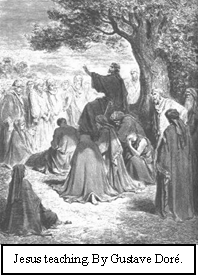Rightly Understanding God’s Word: More Principles of Context, by Craig S. Keener
 My second example from Paul is the trumpet in 1 Thessalonians 4:16 and 1 Corinthians 15:52; the latter text calls it the “last trumpet,” so some interpreters want to parallel it with the seventh trumpet in Revelation. But again, Paul’s original audience had no access to a book that had not been written yet. They could not simply flip over to Revelation to understand what Paul meant by the trumpet. They could not even flip from 1 Thessalonians to 1 Corinthians, since most of the first audience in Thessalonica would not have a copy of 1 Corinthians. (The early Christians probably had heard Paul share Jesus’ teachings with them, and may have known about the trumpet later recorded in Matthew 24:31. In this sense, we can use Jesus’ teachings as “background” for Paul’s message. But jumping carelessly from one author to another, say from Paul to Revelation, can often yield inaccurate results.)
My second example from Paul is the trumpet in 1 Thessalonians 4:16 and 1 Corinthians 15:52; the latter text calls it the “last trumpet,” so some interpreters want to parallel it with the seventh trumpet in Revelation. But again, Paul’s original audience had no access to a book that had not been written yet. They could not simply flip over to Revelation to understand what Paul meant by the trumpet. They could not even flip from 1 Thessalonians to 1 Corinthians, since most of the first audience in Thessalonica would not have a copy of 1 Corinthians. (The early Christians probably had heard Paul share Jesus’ teachings with them, and may have known about the trumpet later recorded in Matthew 24:31. In this sense, we can use Jesus’ teachings as “background” for Paul’s message. But jumping carelessly from one author to another, say from Paul to Revelation, can often yield inaccurate results.)
Most of our letters of Paul are relatively short. By contrast, many of his congregations knew him and were familiar with some points he was making; it is therefore helpful for us to get to know him better by familiarizing ourselves with all his extant writings. This helps us whenever we approach any particular writing of Paul’s.
Anticontext methods to avoid
From Chapter Two: Learning Context
You need not agree with our interpretation of every example cited below, but these examples will suffice to illustrate how frequently we have ignored context. They should also illustrate how context makes a difference in our understanding. In no instance are we challenging specific doctrines people have sometimes based on these verses; we are challenging methods of interpretation. (If some texts in context do not support a doctrine, the doctrine might still be defended if other texts support it.) You will learn context principles best if you actually work through the passages yourself before reading our interpretation of them; this way you will recognize what students in my classrooms usually recognize: when most the students come to the same conclusions independently, they recognize for themselves how clear the point of the text is.
One should also avoid determining the meaning of words by their etymologies. That is, you cannot break a word down into its component parts and always come up with its meaning, and you usually cannot determine the meaning a word has by looking at how it was used centuries earlier or how the word originated. For a contemporary example, if one of my students called me a “nice professor,” they might intend it as a compliment. But if I were committed to understanding words according to their origins, I could grow very angry. In English, “nice” is a friendly term; but its Latin source means “ignorant” or “foolish.” So I could misunderstand someone calling me “nice” as that person calling me “ignorant”! We know that English does not work that way, and we should not expect ancient languages to work that way, either.
Category: Biblical Studies, Summer 2004


